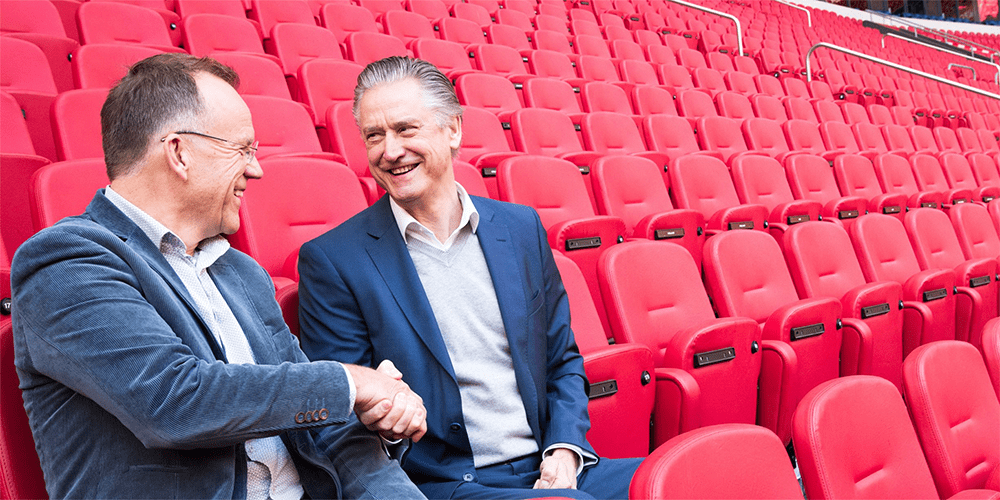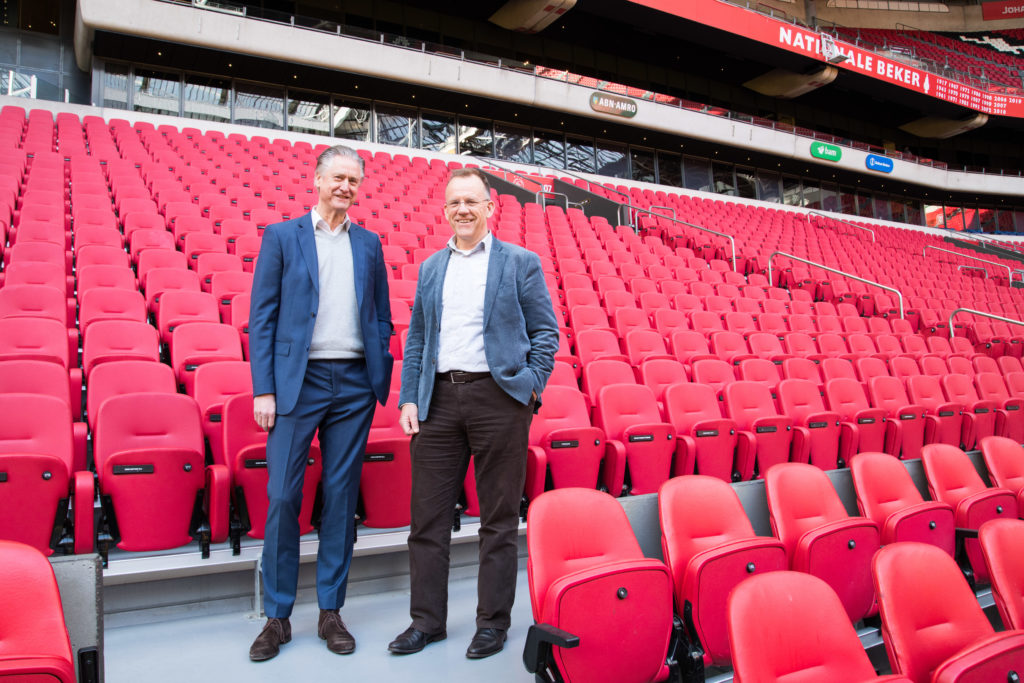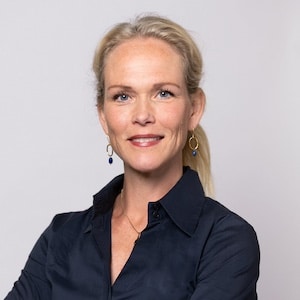Board Talk: werken aan de energietransitie
Met de gemeente Amsterdam als aandeelhouder is de Johan Cruijff ArenA het simpelweg aan zijn stand verplicht om maatschappelijke thema’s bloedserieus te nemen, vindt CEO Henk Markerink. En dat pakken zij uitermate goed op, vindt ‘buurman’ Hans Wichers Schreur, directeur vastgoed en huisvestingsbeleid van de Hogeschool van Amsterdam (HvA).
Dit interview vond plaats in februari 2020, nog vóór de coronacrisis. Daarom wordt er op de foto’s nog geen anderhalve meter afstand gehouden.
Wichers Schreur: “De Johan Cruijff ArenA is niet alleen op de kaart, maar ook in doen en laten een spil in Amsterdam Zuidoost.”
Markerink: “Het onderwerp duurzaamheid kwam tot een hoogtepunt in 2010. De gemeente Amsterdam gaf aan ons graag te zien als uithangbord, een showroom van wat kan op het gebied van energietransitie. Samen met alle partijen die hier werkzaam waren, van het schoonmaakbedrijf tot de aannemer, ondertekenden we een Green Deal: in 2015 willen we klimaatneutraal zijn.”
Die bal werd opgepakt en in 2015 was het stadion, onder andere dankzij zonnepanelen op het dak en stadswarmte, inderdaad klimaatneutraal.
Wichers Schreur: “Ik bewonder jullie just do it-mentaliteit en ben blij dat we nu ook sámen onderzoeken hoe we die energietransitie verder kunnen vormgeven.”
Markerink: “We zitten nadrukkelijk met de gemeente en buren om tafel vanuit de wens om dit hele gebied klimaatneutraal te maken. Ik geloof erg in een wijkgerichte aanpak van dit vraagstuk. Als je het voor de metropoolregio Amsterdam in één keer wilt oplossen, wordt het te veelomvattend en abstract. Dat is killing voor dit soort processen. Mensen verdwijnen in de anonimiteit en deadlines verschuiven eindeloos naar achteren.”
Wichers Schreur: “Wij proberen het antwoord dicht bij huis te zoeken en concrete taken en doelstellingen te formuleren.”
Markerink: “Het centralistische handelen staat ver weg van de werkelijkheid en de belanghebbenden in een situatie. Misschien vraagt het zelfs bestuurlijke vernieuwing om deze complexe operatie gedaan te krijgen. Je moet het probleem proberen plat te slaan, klein maken. Niet top-down, maar bottom-up benaderen. Alleen maar van bovenaf aangeven wat niet mag, werkt niet; de overheid moet optrekken met burgers en bedrijven als gelijkwaardige partners.”
In mei 2020 verschijnt de ‘routekaart naar een duurzaam huisvestingsportfolio’ van de HvA: 49 procent CO2-reductie in 2030 en 95 procent in 2050, of zoveel eerder als kan.
Wichers Schreur: “Elk gebouw dat we in de stad hebben, vergt een andere aanpak. Elektriciteit is te regelen, maar de warmtevraag kun je naar mijn idee alleen maar met de buren oplossen.”
De plannen die de Hogeschool van Amsterdam en de Johan Cruijff ArenA samen smeden, staan nu nog in de kinderschoenen, maar de mannen staan in de starthouding om ze verder uit te werken en in de praktijk te brengen.
Wichers Schreur: “We kunnen elkaar vooruithelpen. Als je over de grenzen van je eigen gebouw kijkt, zie je wat de pieken en dalen in energieverbruik zijn van nabijgelegen bedrijven. ’s Avonds en in het weekend is een schoolgebouw bijvoorbeeld gesloten…”
Markerink: “Ha! Dan wordt hier toevallig gevoetbald.”
Wichers Schreur: “Dus vergeet het bouwen van een uit de kluiten gewassen nieuwe infrastructuur en verleg de capaciteit van de een naar de ander. Zo kun je het onderling oplossen.”
‘Dit zijn onderwerpen die
dwars door belangen heen gaan.
Het was ook niet de auto-industrie
die de Tesla bedacht’
Markerink: “De helft van de elektriciteitscentrales draait de hele dag passief om de piek te kunnen opvangen als iedereen ’s avonds thuiskomt. Door energie te delen en een bups batterijen neer te zetten waarin energie wordt opgeslagen, maak je de helft van die centrales overbodig. Stel, je vraagt aan een bakker en een slager wat we vanavond eten, dan antwoorden zij respectievelijk brood en vlees. Maar dit zijn onderwerpen die dwars door belangen heen gaan. Het is niet in het belang van een energiemaatschappij om alle centrales te sluiten en het op een heel andere manier te organiseren. De oplossingen komen dus vaak uit een andere hoek. Het was ook niet de auto-industrie die de Tesla bedacht.”
De partijen die met elkaar praten over de energietransitie in het gebied zijn onder andere de gemeente, ING, ROC, Ajax, CBRE, BAM, Ballast Nedam en Liander. Laatstgenoemde niet als buurtgenoot, maar als gesprekspartner voor het elektriciteitsnetwerk.
Markerink: “Met hen onderzoeken we de mogelijkheden om windmolens of meer zonnepanelen te plaatsen.”
Wichers Schreur: “De ArenA trapte af en het breidt zich nu als een olievlek uit.”
Markerink: “Het klimaat in dit gebied is uitermate gunstig, omdat er een investeringsprogramma van miljarden op de tekentafel ligt. Woningen, kantoren, onderwijs, entertainment, alles is hier vertegenwoordigd. Nu moeten we vaak achteraf repareren, maar binnenkort hebben we gezamenlijk de kans om hier de duurzame stad van de toekomst te bouwen. By design! We staan op een heel interessant kantelpunt.”
Wichers Schreur: “Zijn er barrières op dit moment?”
Markerink: “De mate van urgentie. Het water staat ons nog niet aan de lippen, dus ach, het komt wel goed: 2030, 2040, 2050. Maar we móeten en kúnnen nu iets gaan doen.”
Wichers Schreur: “Maar dat vergt een andere denkwijze.”
Markerink: “Ja. Mensen overzien het niet en vinden het hartstikke ingewikkeld: een energiecentrale sluiten of de Noordzee vol leggen met panelen? Ik vind dat het wél kan, met die bottom-upbenadering. Zoals wij hier in Zuidoost nu doen samen met de gemeente en buren. Daarmee gaan we niet álles oplossen, maar door de samenwerking te zoeken, kun je een heleboel bereiken per woonwijk, stadsdeel of gebied.”
De eerste gesprekken tussen de partijen vonden in november 2019 plaats naar aanleiding van de Boardstrategiedag van de Amsterdam Economic Board.
Markerink: “Alle uitdagingen van de Board – gezondheid, digitale connectiviteit, talent voor de toekomst, energie, mobiliteit en circulaire economie – komen op een of andere manier terug in onze bedrijfsvoering. Wij hebben veel baat bij de Board en omdat we een soort laboratorium voor dit gebied zijn, heeft de Board weer een beetje baat bij ons. Nieuwe technologie blijft niet beperkt tot onze gevel.”
Wichers Schreur: “Als HvA kunnen wij een bijdrage leveren aan het ‘Living lab for a smart and sustainable city’ van de ArenA. In zo’n laboratorium heeft onderwijs en onderzoek natuurlijk een fantastische plek. Er zijn verschillende studenten die meedenken en meewerken aan verschillende vraagstukken, ook op het energievlak. Die link was er dus al. Nu proberen we het ook in de fysieke wereld toe te passen.”
Markerink: “Het is ook experimenteren, wat werkt wel en wat werkt niet? In juni 2018 namen we een superbatterij van drie megawatt in gebruik om elektriciteit in op te slaan. Dat was geen proven technology, dus dat had wat voeten in de aarde. We zaten om tafel met de brandweer, bouw- en woningdienst, milieudienst, noem maar op. Maar als je potentiële valkuilen met een open mind en toekomstgericht benadert, zie je vooral mogelijkheden. Daartoe zullen veel partijen een kwartslag moeten draaien in hun denken.”
Wichers Schreur: “Vanuit belangen kom je eerder tot oplossingen dan vanuit standpunten en dit zijn uitdagingen voor de toekomst waarvoor iedereen binnen de hogeschool warmloopt. Dat mes snijdt aan verschillende kanten.”
In het verduurzamen van de hogeschoolgebouwen wordt de komende jaren miljoenen geïnvesteerd, maar geduld is een schone zaak.
‘Amsterdam heeft altijd
een grote mond, dus
laten we dat waarmaken’
Wichers Schreur: “Aan dit soort trajecten gaan uitvoerige financiële afwegingen vooraf. Het is niet alleen de business case, het is maatschappelijk geld dat we erin stoppen. We proberen de grenzen op te zoeken en de krachtenbundeling hier in Zuidoost maakt misschien een tempoversnelling mogelijk.”
Markerink: “Het Amsterdamse Klimaat- en Energiefonds financierde een deel van onze zonnepanelen en vanwege het innovatieve karakter van de batterij kregen we een fikse subsidie vanuit Brussel. Er ís veel geld. Meneer Timmermans heeft onlangs nog eens duizend miljard euro op tafel gelegd om de energietransitie in Europa vorm te geven. Amsterdam heeft altijd een grote mond, dus laten we dat waarmaken en die koppositie pakken; we zijn de beste, de snelste en laten de wereld zien hoe het moet. Dan wil iedereen aan boord en is geld geen issue.”
In 2020 gaan boardleden (of hun collega’s) met elkaar in gesprek over de Energietransitie. Wat is hun visie om versneld stappen te zetten en hoe werken ze eraan? Dit is deel één uit de serie.
Tekst en beeld: Marloes Levie
Board Talk
Het interview met Henk Markerink en Hans Wichers Schreur is deel 1 uit de reeks Board Talk. Hierin praten we met Boardleden over de grootste uitdagingen voor de Amsterdamse metropool. Een regio die een duurzame, gezonde leefomgeving biedt, verantwoorde digitalisering en waardevol werk voor iedereen. Dit zijn ook de belangrijkste thema’s voor Amsterdam Economic Board. Lees ook de andere interviews in de serie Board Talk.
Wil jij voortaan ons belangrijkste nieuws in je mailbox ontvangen? Meld je dan hier aan voor onze Board Update.
20 juli 2020
Meer weten over
Neem contact op
Blijf jij ook op de hoogte?
8x per jaar nieuws en events uit de regio: schrijf je in voor de Board Update nieuwsbrief
Deel dit artikel
Wil je op de hoogte blijven?
Volg ons dagelijks op LinkedIn en schrijf je in voor de Board Update nieuwsbrief.
Lees ook deze berichten
- Een nieuwe lichting gedreven jongeren is aangetreden bij Young on Board, de ...
- Met de selectie van vier kanshebbers is de regionale voorronde van de ...
- Met meer dan 80 ondernemers, 40 investeerders en diverse dienstverleners bood LSH Capital Match ...




